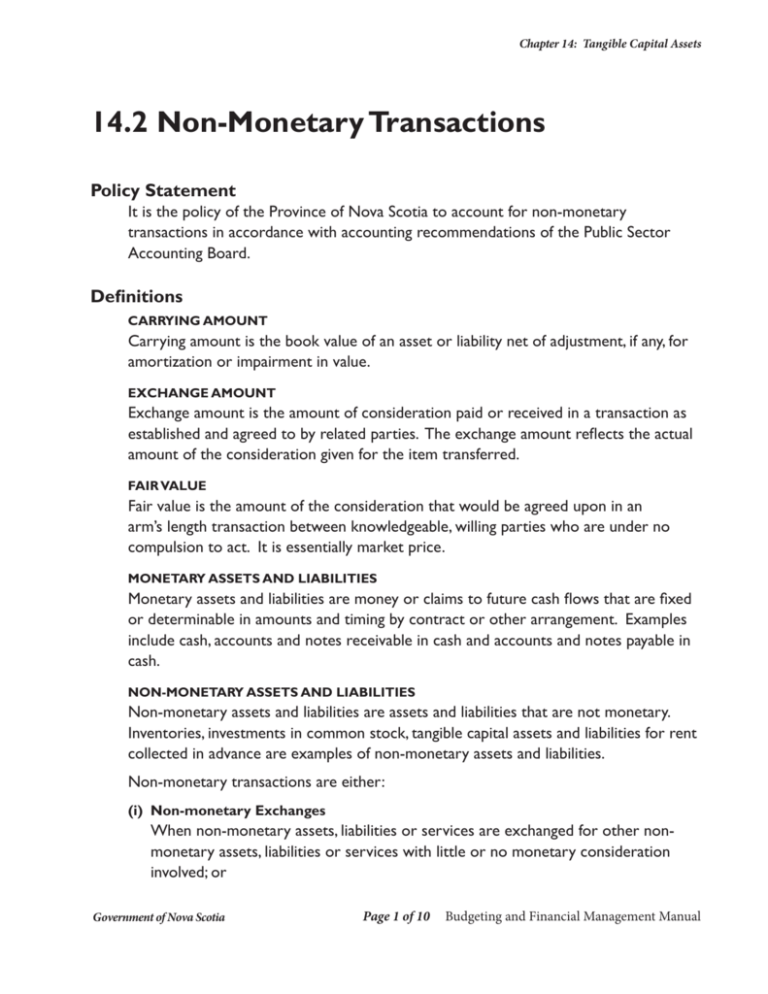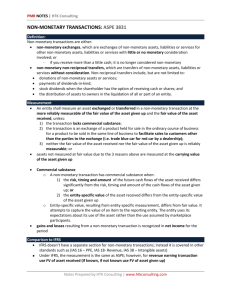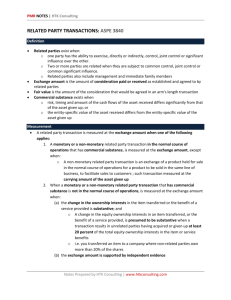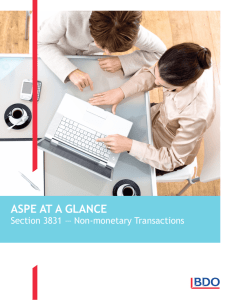14.2 Non-Monetary Transactions
advertisement

Chapter 14: Tangible Capital Assets 14.2 Non-monetary Transactions 14.2 Non-Monetary Transactions Policy Statement It is the policy of the Province of Nova Scotia to account for non-monetary transactions in accordance with accounting recommendations of the Public Sector Accounting Board. Definitions CARRYING AMOUNT Carrying amount is the book value of an asset or liability net of adjustment, if any, for amortization or impairment in value. EXCHANGE AMOUNT Exchange amount is the amount of consideration paid or received in a transaction as established and agreed to by related parties. The exchange amount reflects the actual amount of the consideration given for the item transferred. FAIR VALUE Fair value is the amount of the consideration that would be agreed upon in an arm’s length transaction between knowledgeable, willing parties who are under no compulsion to act. It is essentially market price. MONETARY ASSETS AND LIABILITIES Monetary assets and liabilities are money or claims to future cash flows that are fixed or determinable in amounts and timing by contract or other arrangement. Examples include cash, accounts and notes receivable in cash and accounts and notes payable in cash. NON-MONETARY ASSETS AND LIABILITIES Non-monetary assets and liabilities are assets and liabilities that are not monetary. Inventories, investments in common stock, tangible capital assets and liabilities for rent collected in advance are examples of non-monetary assets and liabilities. Non-monetary transactions are either: (i) Non-monetary Exchanges When non-monetary assets, liabilities or services are exchanged for other nonmonetary assets, liabilities or services with little or no monetary consideration involved; or Government of Nova Scotia Page 1 of 10 Budgeting and Financial Management Manual Chapter 14: Tangible Captial Assets 14.2 Non-monetary Transactions (ii) Non-monetary Non-reciprocal Transfers When non-monetary assets, liabilities or services are transferred without any consideration given in return. Donations of tangible capital assets are an example of non-monetary non-reciprocal transfers. RELATED PARTIES Related parties exist when one party has the ability to exercise, directly or indirectly, control, joint control or significant influence over the other. Two or more parties are related when they are subject to common control, joint control or common significant influence. The province and the entities within the Government Reporting Entity (GRE) are related parties as the province has the ability to exercise control over the other entities within the GRE. As well, the entities within the GRE are related parties (e.g., a district health authority and a regional school board) as they are subject to common control of the province. RELATED PARTY TRANSACTION A related party transaction is a transfer of economic resources or obligations between related parties, or the provision of services by one party to a related party, regardless of whether any consideration is exchanged. The parties to the transaction are related prior to the transaction. Refer to 14.3 Non-Monetary Related Party Transactions. TANGIBLE CAPITAL ASSET A Tangible Capital Asset (TCA) is a non-financial asset that is purchased, constructed or developed and: i) is held for use in the production or supply of goods and services, for rental to others, for administrative purposes or for development, construction, maintenance or repair of other capital assets; ii) requires operating and maintenance expenditures and may need to be replaced in the future; iii) has a useful life extending beyond an accounting period and is intended to be used on a continuing basis; and, iv) is not intended for sale in the ordinary course of operations. Policy Objectives The objective of this policy is to ensure non-monetary transactions are accounted for appropriately and accurately. Government of Nova Scotia Page 2 of 10 Budgeting and Financial Management Manual Chapter 14: Tangible Capital Assets 14.2 Non-monetary Transactions Application This policy applies to the province’s departments, agencies, boards, and commissions of the General Revenue Fund. Policy Directives Non-monetary transactions should be accounted for in accordance with Section 3831 Non-Monetary Transactions, CICA Handbook. For those non-monetary transactions between related parties, refer to 14.3 NonMonetary Related Party Transactions. MEASUREMENT In order to preserve an objective measurement of the value of a transaction, generally, a non-monetary transaction is measured at the fair value, with a general exception for transactions that do not have commercial substance (as described below). There is a general requirement to measure an asset or liability exchanged or transferred in a non-monetary transaction at the more reliably measurable of: • the fair value of the asset given up; and • the fair value of the asset received. When an entity is able to reliably determine the fair value of both the asset received and the asset given up, the fair value of the asset given up is used to measure the value of the asset received unless the fair value of the asset received is more reliably measurable. However, an asset exchanged or transferred in a non-monetary transaction is measured at its carrying amount (i.e., book value) when: • the transaction lacks commercial substance; • the transaction is an exchange of a product or property held for sale in the ordinary course of business for a product or property to be sold in the same line of business to facilitate sales to customers other than the parties to the exchange; • neither the fair value of the asset received nor the fair value of the asset given up is reliably measurable; or • the transaction is a non-monetary non-reciprocal transfer to owners that represents a spin-off or other form of restructuring or liquidation. Government of Nova Scotia Page 3 of 10 Budgeting and Financial Management Manual Chapter 14: Tangible Captial Assets 14.2 Non-monetary Transactions For non-monetary transactions that are not measured at fair value, an entity should measure an asset exchanged or transferred at the carrying amount (after reduction, when appropriate, for impairment) of the asset given up, adjusted by the fair value of any monetary consideration received or given. The entity paying the monetary consideration measures the non-monetary asset received at the carrying amount of the asset given up plus the fair value of the monetary consideration paid. The entity receiving the monetary consideration measures the non-monetary asset received at the carrying amount of the asset given up less the fair value of the monetary consideration received, unless the monetary consideration exceeds the carrying amount, in which case a gain is recognized for the amount of such excess. COMMERCIAL SUBSTANCE A transaction is deemed to have commercial substance if it causes an identifiable, measurable change in the economic circumstances of the entity. Commercial substance is a function of the cash flows expected by the reporting entity. A nonmonetary transaction has commercial substance when the entity’s future cash flows are expected to change significantly as a result of the transaction. The entity’s future cash flows are expected to change significantly as a result of the transaction when either of the following conditions is met: • the risk, timing or amount of the future cash flows of the asset received differs significantly from that of the asset given up (e.g., a change in the type of asset owned may represent a change in the risk of the cash flows from the asset); or • the entity-specific value of the asset received differs from that of the asset given up, and the difference is signficant relative to the fair value of the assets exchanged (e.g., realization of cost savings; realization of additional revenues). The term “entity-specific value” is a measure of the value of an asset in the context of the entity owning the asset. It includes all of the cash flow effects of a transaction on the entire entity. The entity uses its expectations about its use of the asset rather than the use assumed by marketplace participants. DONATIONS – DEPARTMENTAL GRANT EXPENSE In order to reflect the resulting decrease in resources, donations of tangible capital assets by the province are recorded by departments of the General Revenue Fund as departmental grant expense (i.e., a donation in lieu of a grant). The amount of departmental grant expense to be recorded is measured as per the above Measurement section. Government of Nova Scotia Page 4 of 10 Budgeting and Financial Management Manual Chapter 14: Tangible Capital Assets 14.2 Non-monetary Transactions WRITE-DOWNS – DEPARTMENTAL OPERATING EXPENSE 14.1 Tangible Capital Assets Policy states “The net book value of a tangible capital asset is to be written down when conditions indicate the tangible capital asset no longer contributes to the government’s ability to provide services or the future economic benefits are less than the net book value. Write-downs are not to be reversed. The amount of the write-down represents a charge against the department’s budget appropriation.” Policy Guidelines Each non-monetary transaction should be evaluated on an independent basis and the determination of the appropriate accounting treatment for each transaction requires the use of professional judgement. See examples described in Appendix 14-E. Accountability Departments are responsible for identifying and assessing non-monetary transactions. In addition, departments are responsible to ensure the appropriate accounting treatment for non-monetary transactions. Government Accounting is responsible for providing guidance and advice relating to the appropriate accounting treatment for non-monetary transactions. Monitoring Government Accounting will monitor the policy’s implementation, performance, and effectiveness. References CICA Handbook, Section 3831 Non-Monetary Transactions CICA Handbook, Section 3840 Related Party Transactions 14.1, Tangible Capital Assets Policy Appendices Appendix 14-D Appendix 14-E Government of Nova Scotia Non-monetary Transactions Decision Tree Examples Page 5 of 10 Budgeting and Financial Management Manual Chapter 14: Tangible Captial Assets 14.2 Non-monetary Transactions Enquiries Director, Government Accounting Department of Finance (902) 424-7021 Approval date: July 31, 2008 Effective date: August 21, 2008 Approved by: Executive Council Administrative update: October 7, 2010 Government of Nova Scotia Page 6 of 10 Budgeting and Financial Management Manual Chapter 14: Tangible Capital Assets 14.2 Non-monetary Transactions Appendix 14-D Decision tree The following decision tree is provided for illustrative purposes. Non-monetary transaction occurs YES Does the transaction lack commercial substance? NO YES Is the transaction an exchange of product or property held for sale in the ordinary course of business to be sold in the same line of business to facilitate sales to customers other than the parties to the exchange? NO YES Neither the fair value of the asset received or the asset given up is reliably measurable. NO YES Is the transaction a non-monetary non-reciprocal transfer to owners that represents a spin-off or other form of restructuring or liquidation? NO Measure at carrying amount (a) Measure at fair value (b) (a) The carrying amount of the asset given up is adjusted by the fair value of any monetary consideration received or given. (b) The fair value of the asset given up is used to measure the asset received unless the fair value of the asset received is more reliably measurable. Government of Nova Scotia Page 7 of 10 Budgeting and Financial Management Manual Chapter 14: Tangible Captial Assets 14.2 Non-monetary Transactions Appendix 14-E Examples The following examples demonstrate the appropriate accounting treatment for transactions with entities outside the Government Reporting Entity (GRE), nonrelated parties, in a variety of circumstances. Example 1 EXCHANGE OF TCA – LACKS COMMERCIAL SUBSTANCE The province exchanges a parcel of land with a carrying amount of $3,800 with an entity external to the GRE for a different parcel of land with a fair value of $7,500. The province assesses the transaction and determines that it lacks commercial substance; as a result, the transaction should be recorded at the carrying amount of the asset given up. The province would record the exchange as follows: Debit: Credit: TCA-Land (Parcel received) TCA-Land (Parcel given up) $3,800 ($3,800) Example 2 EXCHANGE OF TCA INVOLVING PARTIAL MONETARY CONSIDERATION – LACKS COMMERCIAL SUBSTANCE The province exchanges a parcel of land with a carrying amount of $3,800 and fair value of $7,000 with an entity external to the GRE for a different parcel of land with a fair value of $7,500. The province also pays $500 cash to balance the fair values of the parcels of land exchanged. The province assesses the transaction and determines that the transaction lacks commercial substance; as a result, the transaction should be recorded at the carrying amount of the asset given up. The entity paying the monetary consideration measures the non-monetary asset received at the carrying amount of the asset given up ($3,800) plus the fair value of the monetary consideration paid ($500). The province would record the exchange as follows: Debit: Credit: Credit: Government of Nova Scotia TCA-Land (Parcel received) TCA-Land (Parcel given up) Cash Page 8 of 10 $4,300 ($3,800) ($500) Budgeting and Financial Management Manual Chapter 14: Tangible Capital Assets 14.2 Non-monetary Transactions Example 3 EXCHANGE OF TCA – COMMERCIAL SUBSTANCE The province exchanges a parcel of land with a carrying amount of $20,000 and fair value of $22,000 with an entity external to the GRE for a different parcel of land with a fair value of $25,000. The province assesses the transaction and determines that it has commercial substance; as a result, the asset received should be measured at the fair value of the asset given up. The province would record the exchange as follows: Debit:TCA-Land $22,000 Credit: TCA-Land ($20,000) Credit: Gain on Disposal of Assets ($2,000) Example 4 DONATION OF TCA – DEPARTMENTAL GRANT EXPENSE The province donates a parcel of land in exchange to an entity external to the GRE for a nominal amount of $1. The carrying amount of the land is $72,000, and the fair value of the land is $1,500,000. The province assesses the transaction and determines that it has commercial substance; as a result, the transaction should be recorded at the fair value of the asset given up. The province would record the transfer as follows: Debit: Debit: Credit: Credit: Cash Departmental Grant Expense TCA-Land Gain on Disposal of Assets $1 $1,499,999 ($72,000) ($1,428,000) Example 5 DONATION OF TCA INVOLVING PARTIAL MONETARY CONSIDERATION – DEPARTMENTAL GRANT EXPENSE The province donates a piece of land with a zero carrying amount and fair value of $129,000 to an entity external to the GRE for $3,000 cash. The province assesses the transaction and determines it has commercial substance; as a result, the transaction should be recorded at the fair value of the asset given up. The province would record the transfer as follows: Debit: Debit: Credit: Government of Nova Scotia Cash Departmental Grant Expense Gain on Disposal of Assets Page 9 of 10 $3,000 $126,000 ($129,000) Budgeting and Financial Management Manual Chapter 14: Tangible Captial Assets 14.2 Non-monetary Transactions Example 6 DONATION OF IMPAIRED TCA – DEPARTMENTAL OPERATING AND GRANT EXPENSE The province donates property to an entity external to the GRE for a nominal amount of $1. The carrying amount of the property is $4,400,000 which is in excess of the $1,200,000 fair value of the property. The value of future economic benefits associated with the property is less than its net book value. Since this reduction is expected to be permanent, the province determines that a write-down of the property is appropriate. The province would record the write-down of the property as follows (14.1 Tangible Capital Assets Policy): Debit: Credit: Departmental Operating Expense TCA-Land & Buildings $3,200,000 ($3,200,000) The province assesses the transaction and determines it has commercial substance; as a result, the transaction should be recorded at the fair value of the asset given up. The province would record the transfer as follows: Debit: Debit: Credit: Government of Nova Scotia Cash Departmental Grant Expense TCA-Land & Buildings $1 $1,199,999 ($1,200,000) Page 10 of 10 Budgeting and Financial Management Manual







